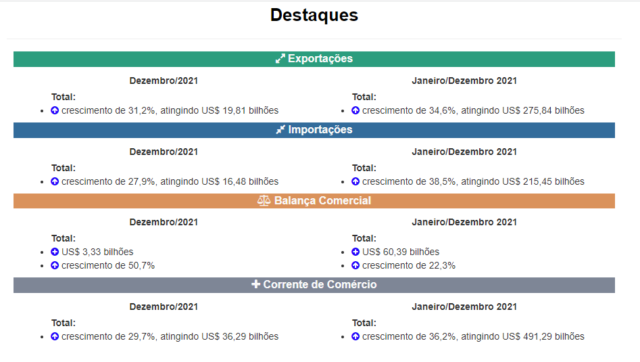
Balance surplus rises 22.3% and reaches US$ 60.39 billion in the year
Dec, 27, 2021 Posted by Gabriel MalheirosWeek 202150
The Brazilian trade balance is operating on a surplus of US$ 60.39 billion based on the YTD calculated with the data available up to the fourth week of December, showing an increase of 22.3% in the daily average vis-a-vis the same period (January to December) last year. On the other hand, trade flow (here understood as the sum of exports and imports) reached US$ 491.29 billion, a growth of 36.2%.
Exports in 2021 yielded a total value of US$ 275.84 billion, an increase of 34.6%, while imports rose 38.5% and, reaching a total of US$ 215.45 billion. The data were released this Monday (12/27) by the Foreign Trade Secretariat (Secex) of the Ministry of Economy.
In the year to date, exports grew 31.2% and totaled US$ 19.81 billion, while imports rose 27.9% and totaled US$ 16.48 billion. As a result, the trade balance registered a surplus of US$ 3.33 billion, up 50.7%, and the trade flow reached US$ 36.29 billion, up 29.7%.
In the fourth week of December alone, exports totaled US$ 5.15 billion, while imports totaled US$ 3.96 billion. Thus, the trade balance registered a surplus of US$ 1.18 billion and the trade flow reached US$ 9.12 billion.
Exports in the month
In terms of exports, there was a growth of 31.2% on the daily average of December 2021 (US$ 838.71) vis-a-vis the daily average registered in December 2020 (US$ 838.71) as a result of the increase in sales enacted by the extraction industry (+20.2%), the manufacturing industry (+31.5%) and Agriculture (+51.5%).
In the extraction industry, the highlights were the sales of crude petroleum oil and bituminous minerals (+102.7%); copper ores (+59.1%); other raw minerals (+65.3%), and nickel ores (+ 41%).
As for the manufacturing industry, growth was driven by semi-finished products, ingots, and other primary forms of iron or steel (+146.1%); soy bran and other animal feed, except unground cereals, meat (+79%); cellulose (+67%); vegetable fats and oils, either “soft”, crude, refined or fractioned (+869.6%) and pig iron, iron sponges, granules, steel powder and ferroalloys (+49.3%).
Among agricultural products, the rise in exports mainly reflected the growth in soybean sales (+1,222.1%); unroasted coffee (+24.3%); unground wheat and rye (+208.5%); spices (+133.6%) and non-oily nuts and fruits, either fresh or dried (+14%).
Imports in the month
In terms of imports, the daily average (US$ 915.57 million) was 27.9% above the average of December 2020 (US$ 715.84 million). In this, purchases from the manufacturing industry (+20.8%), agriculture (+17.6%), and also the products from the extraction Industry (+225.3%) increased.
In the manufacturing industry, the increase in imports was driven by the growth in purchases of organic and chemical fertilizers, excluding raw fertilizers (+138.4%); fuel oils from petroleum or bituminous minerals, except crude oils (+ 84.8%); thermionic tubes, cold cathode or photocathode tubes, diodes, transistors (+80.2%); medicines and pharmaceutical products, except veterinary ones (+77.4%) and non-electric engines and machines, as well as their parts, except piston engines and generators (+107.2%).
In Agriculture, the increase was mainly due to the purchase of unground corn, excluding sweetcorn (+227.4%); unground wheat and rye (+54.9%); latex, natural rubber, balata, gutta-percha, guayule, chewing gum, and natural gums (+17.3%); live, dead or chilled fish (+7.6%) and raw cotton (+676.9%)
To conclude, in the extraction industry, the increase in imports is mainly due to the purchase of natural gas, either liquefied or not (+529%); coal (+289.6%); crude petroleum oils or crude bituminous minerals (+21.8%); other ores and base metals (+171.3%) and raw fertilizers, excluding manure (+47%).
-
Other Logistics
Mar, 21, 2021
0
T’Trans to supply wagons for MRS
-
Ports and Terminals
Jul, 12, 2021
0
BTP attests to 100% clean energy usage
-
Grains
May, 17, 2021
0
Gambia and Costa Rica lead rice imports from Brazil in April
-
Other Cargo
Apr, 12, 2024
0
Brazilian Footwear Industry Grapples with Export Decline Amid Surging Asian Imports



